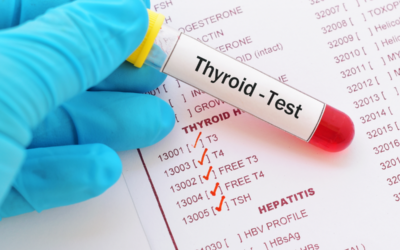Thyroid disorders, including hypothyroidism, are less common in men, but men can also be affected by this hormonal disorder. The lower incidence of the disorder in men can lead to under-diagnosis and treatment delays. To remedy this problem, raising awareness of this condition is important, especially as symptoms are not always easy to identify.
Role of the thyroid
The thyroid is a small endocrine gland that secretes hormones. It is located under the skin of the neck, and is normally invisible and you cannot feel it. When it is working properly, the thyroid hormones it produces regulate the metabolism, including growth, digestion, skin, sleep, mood and heart rate. The thyroid can sometimes be underactive, leading to hypothyroidism. The thyroid gland weighs around 20 g. It needs iodine from the diet to work properly.
The pituitary gland is a small gland in the brain that secretes the thyroid stimulating hormone (TSH), which regulates the production of thyroid hormones. Thanks to this hormone, the thyroid secretes triiodothyronine (T3) and thyroxine (T4), which also act on the metabolism.
As the thyroid fulfils the same role in both men and women, the symptoms and treatments are similar. However, the lower prevalence of thyroid disorders in men can lead to late diagnosis, as symptoms may be discreet or downplayed, or mistakenly associated with other health problems. In such situations, raising the awareness of patients and teaching them how to recognise the symptoms of hypothyroidism, and to see a doctor if they are unsure, may be helpful.
Hypothyroidism: a few figures
Hypothyroidism is the most common thyroid disease, affecting 1-2% of the population. This figure rises to 4% after the age of 65. The number of new cases in men is 1/1000.
What is hypothyroidism?
Hypothyroidism refers to low activity of the thyroid gland. When T3 and T4 hormone levels are low, the metabolism and body as a whole, slows down. Facial symptoms include puffy eyes, drooping eyelids or altered facial expression.
Other symptoms are more general and less specific such as:
- Weight gain;
- Dry or brittle skin, hair and nails
- Depression;
- Fatigue;
- Sensitivity to the cold;
- Constipation;
- Heart rhythm problems.
The following symptoms can also be observed, especially in men:
- Decreased libido;
- Erectile dysfunction;
- Lower sperm count.
In men, some symptoms can easily go unnoticed or be attributed to other causes, such as ageing or lifestyle, e.g. hair loss, fatigue or weight gain. A combination of these symptoms could suggest a hormonal disorder, especially a thyroid disorder.
Raising awareness of these symptoms is important as late diagnosis can lead to delayed treatment, a worsening of symptoms and patient anxiety. Initiatives such as the International Thyroid Awareness Week can help to improve diagnosis by informing the general public and those most at risk.
Men after the age of 50 are more a risk from heart disease. As atherosclerotic plaque, angina pectoris and high cholesterol levels are associated with hypothyroidism, closer monitoring of thyroid function is therefore relevant in patients with such risks.
Special case of elderly patients
After the age of 65, the incidence of hypothyroidism increases in both sexes, affecting up to 6% of men. In this age range, the symptoms also tend to be less intense, which can complicate the diagnosis, especially in men. It is therefore important to be aware of thyroid disorders in older men.
Types of hypothyroidism
Hypothyroidism may be primary, particularly in the following cases:
Hashimoto’s thyroiditis: This is an autoimmune disease (i.e. the immune system attacks the thyroid) that often triggers hypothyroidism. The thyroid becomes swollen (called a goitre), but is not painful. It is the most common type of thyroiditis in North America. As it is an autoimmune disease, it can be associated with other diseases of the same type, including type 1 diabetes, connective tissue diseases and coeliac disease. Men with these conditions are more at risk of developing Hashimoto’s thyroiditis.
Inflammation of the thyroid gland: This is a temporary condition which generally follows an ordinary viral infection, and usually progresses to spontaneous recovery.
Iodine deficiency: This is the most common cause of hypothyroidism in developing countries, but is rare in developed countries where the diet is supplemented with iodine.
Secondary hypothyroidism is much rarer and is caused by insufficient TSH secretion by the pituitary gland. It affects the pituitary gland which leads to thyroid dysfunction.
Diagnosing hypothyroidism
If you have symptoms suggestive of hypothyroidism, whether primary or secondary, you should see a doctor, who will be able to diagnose the condition by checking your TSH levels with a blood sample. If the TSH level is abnormal, other thyroid hormones will be analysed. Imaging is not generally required. An underactive thyroid is associated with high TSH levels. The general practitioner can then prescribe treatment on the basis of the test results and monitor the patient accordingly.
Treatments
Hypothyroidism is treated with hormone replacement therapy. This is an oral medication based on synthetic T4 hormones, especially levothyroxine, which compensate for the thyroid hormone deficiency in the body. Treatment generally begins with a low dose which is gradually increased until reaching a dose providing a satisfactory level of thyroid hormones. In the case of an iodine deficiency, changing the diet or taking iodine supplements can restore the thyroid function.




